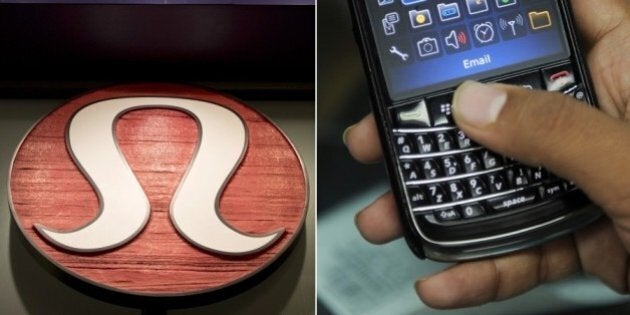
Two internationally renowned Canadian brands have made 24/7 Wall St.'s list of brands that will disappear in 2015.
The financial news site says Vancouver-based yogawear maker Lululemon is among a number of fashion retailers who are in trouble because they have found themselves in "highly competitive spaces."
The site notes it had predicted in 2012 that BlackBerry maker Research In Motion would disappear. The company, now named BlackBerry, continues to see shrinking revenue and "is about to run out of its nine lives."
Read the full report from 24/7 Wall St. below.
24/7 Wall St.: Each year, 24/7 Wall St. identifies 10 brands that we predict will disappear before the end of the next year. This year’s list reflects the fact that mergers and acquisitions are at unprecedented levels. While some of the companies on this list may disappear because they continue to be at the bottom of their industry due to weak products and management, many may disappear because they are doing so well.
Retail continues to be one of the sectors with several troubled companies that may have to be sold to survive. The 24/7 Wall St. list includes Lululemon Athletica Inc. and Aeropostale Inc. Both specialty retailers are in highly competitive spaces. While Lululemon is battling Gap’s aggressive move into the yoga pants space, Aeropostale’s teen line of branded clothes is losing out to low-cost, fashion-forward brands like Forever 21 and H&M.
The consolidation of the broadband industry may also cause some companies to disappear. Time Warner Cable Inc. will likely be sold to Comcast Corp. DirecTV will likely be bought by AT&T Inc. These transactions are part of a much larger movement to become the exclusive providers of entertainment to American homes.
While telecom companies interested in increasing market share have the option to install a fiber network to take market share from cable, that comes at a great cost. Merger trends in the industry indicate it may be better to buy than to build. Comcast and AT&T certainly believe so. Having a larger market share could also allow these companies greater price leverage with content providers like Netflix and premium cable channels.
Adoption of mobile and the massive size of some of Web 2.0 companies has also contributed to the list. Zynga Inc. was well positioned when it was able to market Farmville to Facebook’s users. But it is doing poorly after failing to come up with another hit, moving slowly on mobile and losing its special relationship with the social networking giant.
While Shutterfly Inc. makes a tidy profit selling photos for greeting cards and calendars, it is also up against free photo sharing services such as Instagram and Facebook Inc. The photo printing site is currently looking for a buyer.
A number of the biggest food packaging companies are also in the market. Russell Stover is the third largest chocolate company in America. However, third place is miles behind the leaders, particularly Hershey Co. Stover’s management has decided to give up operating on its own and has put itself on the market.
Hillshire Brands Co. will also almost certainly be sold this year. It has already signed an agreement with Tyson Foods Inc. But Tyson did not get the prize without an expensive fight with Pilgrim’s Pride Corp., which gives a sense of the value of food companies to their rivals.
In 2012, we predicted that Research In Motion would disappear. Last year, the company changed its name to BlackBerry Ltd. The company is on the list again this year under the new name. The company continues to be in serious trouble after being wildly successful for many years.
Reviewing last year’s list, we have had some winners and some bad calls. We called Nook and Leap Wireless correctly. Last month, Barnes & Noble announced it would spin off its Nook e-reader as sales continue to plunge. Leap Wireless was acquired by AT&T late last year.
We have yet to be proven right — or wrong — about the balance of the list. Revenues for Martha Stewart Living and Road & Track magazines continue to be weak, but they also remain in the business. Sales of Mitsubishi and Volvo are among the lowest in the auto industry, but you can still buy their cars. Similarly, LivingSocial continues to offer deals, WNBA to sell tickets and Olympus to make cameras. While these calls haven’t proven right yet, we have until the end of the year.
After five years of making predictions, we are proud of our record. Out of the 49 companies that have made our list, 24 have disappeared. Given that these brands were chosen from a universe of thousands, we think it’s an impressive record.
We continue to use the same methodology in deciding which brands will disappear. The major criteria include:
Declining sales and losses;
Disclosures by the parent of the brand that it might go out of business;
Rising costs that are unlikely to be recouped through higher prices;
Companies that are sold;
Companies that go into bankruptcy;
Companies that have lost the great majority of their customers; and
Operations with withering market share.
Each brand on the list suffers from one or more of these problems. Each of the 10 will be gone, based on our definitions, within 18 months.
This is 24/7 Wall St.’s 10 brands that will disappear in 2014.
